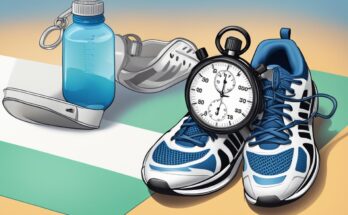For many people, running can be a challenging and daunting task. Whether you’re a beginner or a seasoned runner, it’s not uncommon to wonder when running will start to feel easier. While there’s no one-size-fits-all answer, there are some general guidelines to keep in mind.
First, it’s important to understand that running is a high-impact exercise that can take a toll on your body, especially if you’re new to it. It’s normal to experience muscle soreness, fatigue, and even shortness of breath when you first start running. However, with time and consistency, your body will adapt and become more efficient at running, making it feel easier. The key is to start slow and gradually increase your mileage and intensity over time.
Understanding the Basics of Running
Running is a popular form of exercise that offers many benefits for the body and mind. Whether you’re a beginner runner or an experienced athlete, it’s important to understand the basics of running to get the most out of your workouts.
The Benefits of Running
Running is a great way to improve your overall fitness and endurance. It can help you lose weight, build muscle, and increase your energy levels. Regular running can also improve your cardiovascular health, reduce your risk of chronic diseases, and boost your mood and mental health.
Running Form and Pace
Good running form is essential for preventing injuries and improving your performance. When running, it’s important to maintain a good posture, keep your arms relaxed, and land on the middle of your foot. Your pace should also be appropriate for your fitness level and goals.
The Importance of Warm Up and Stretching
Before starting your run, it’s important to warm up your muscles and prepare your body for exercise. Dynamic warm up exercises such as leg swings, lunges, and high knees can help improve your range of motion and prevent injuries. After your run, stretching can help improve your flexibility and reduce muscle soreness.
It’s also important to stay hydrated during your run and take rest days to allow your body to recover and rebuild. A proper training plan can help you gradually increase your mileage and improve your endurance without overtraining.
By understanding the basics of running, you can make the most of your workouts and achieve your fitness goals.
Challenges Faced by Runners
Running is a challenging physical activity that requires a lot of effort and dedication. It is not uncommon for runners to face various challenges while training or competing. Some of the most common challenges faced by runners include mental and physical challenges, as well as common running injuries.
Mental and Physical Challenges
One of the biggest challenges faced by runners is mental and physical fatigue. Running can be a mentally and physically exhausting activity, especially for beginners or those who are not used to regular exercise. Negative thoughts and lack of motivation can also be a challenge for runners, making it difficult to stay focused and committed to their training program.
In addition to mental challenges, runners may also face physical challenges such as cardiovascular strain, muscle pain, and fatigue. It is important for runners to listen to their bodies and slow down or take a rest day when necessary to avoid injury and promote recovery.
Common Running Injuries
Another challenge faced by runners is the risk of common running injuries. Some of the most common running injuries include shin splints, plantar fasciitis, IT band syndrome, and stress fractures. These injuries can be caused by a variety of factors such as overtraining, improper running form, and inadequate rest and recovery.
To prevent common running injuries, runners should focus on building leg strength, improving running form, and incorporating strength training exercises into their training program. It is also important to wear proper running shoes and take rest days to allow the body to recover and avoid overuse injuries.
Overall, running can be a challenging but rewarding activity for individuals of all ages and fitness levels. By addressing mental and physical challenges and taking steps to prevent common running injuries, runners can enjoy the many benefits of this popular form of exercise.
Ways to Make Running Feel Easier
Strengthening the Muscles
One way to make running feel easier is to strengthen the muscles used in running. This can be done through a variety of exercises such as squats, lunges, and calf raises. Strengthening these muscles can help improve form, reduce the risk of injury, and increase stamina.
Listening to Music or Audiobooks
Listening to music or audiobooks can also make running feel easier. Music can help distract from the monotony of running, while audiobooks can help pass the time and keep the mind engaged. It is important to choose music or audiobooks that are upbeat and motivational to help keep the runner going.
Following a Training Program
Following a training program, such as the popular Couch to 5k program, can also make running feel easier. These programs provide a structured plan for gradually increasing distance and intensity, which can help build stamina and reduce the risk of injury. It is important to choose a program that is appropriate for the runner’s fitness level and goals.
Working with a Running Coach or Doctor
Working with a running coach or doctor can also make running feel easier. A coach can provide personalized guidance and feedback on form, training, and equipment. A doctor can help address any underlying health issues that may be affecting the runner’s performance, such as chafing or breathing problems.
Overall, by incorporating these strategies into their training routine, runners can make running feel easier and more enjoyable, while also improving their fitness and form.



